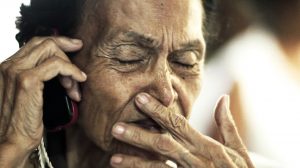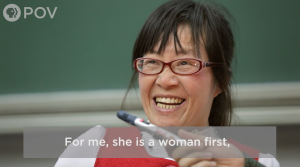Lost Boys of Sudan: Film Description
 After surviving a harrowing trek across hundreds of miles of desert, an estimated 11,000 “Lost Boys” found the protection of the U.N. They crossed the Sudan border into Kenya and were taken to Kakuma refugee camp where they spent the next 9 years waiting for an end to their country’s Civil War.
After surviving a harrowing trek across hundreds of miles of desert, an estimated 11,000 “Lost Boys” found the protection of the U.N. They crossed the Sudan border into Kenya and were taken to Kakuma refugee camp where they spent the next 9 years waiting for an end to their country’s Civil War.
Lost Boys of Sudan tells an astonishing tale of two young men out of the thousands of young Dinka boys and girls who were orphaned and made refugees by Sudan’s brutal 20-year civil war. For Peter Nyarol Dut and Santino Majok Chuor, having their villages destroyed and families killed, and being forced to flee into an unforgiving desert, marks the beginning of another incredible journey. Their journey to America is one of good fortune but one also of cultural, spiritual and even physical vertigo. The distances traveled by the “lost boys” encompass a world of rapid movement and jarring contrasts, and reveal both great social divisions and remarkable human links in the 21st century global village.
Typically in African pastoral society, young boys do the daily work of herding a family’s goats and cattle. That’s how Santino and Peter, like thousands of other Dinka boys, came to be away from their homes when their villages were attacked and wiped out by military forces of the central government. For over 20 years, Sudan’s government has been controlled by a military regime dominated by radical northern Islamists. These regimes have waged a progressively more violent campaign of forced Islamization against southern Christian and animist Sudanese, including the Dinka and Nuer peoples. Southern resistance to the government has been led by the Sudanese Peoples Liberation Army (SPLA). It is estimated that two million Sudanese have died in the civil war. Boys like Santino and Peter had no choice but to flee for their lives into the desert — without knowing who among their families had died or survived. They formed small bands for mutual support and endured hunger, thirst, burning sands and continued military assaults. They also had to contend with the attacks of lions, which found the smallest boys the easier targets.
The lucky ones made it to U.N. refugee camps in Kenya and Ethiopia. Santino and Peter arrived in the Kakuma refugee camp, where food, shelter and relative safety could ease their physical suffering but would do little to heal their nightmarish memories or their fears over the fate of their families.
Only the bonds between them, formed not only of a common background, but also of the hardships they had endured together, seem to provide the boysnow teenagers and young men — with spiritual solace. That’s why it is with equal parts heartbreak and elation that they receive news that some of them, including Santino and Peter, have been sponsored for resettlement in the United States. Already fearing the loneliness and homesickness that may lie ahead, Santino and Peter promise never to forget their comrades and to tell their collective story in the U.S. for all to know. Their friends are convinced the two boys are going to “heaven” and their elders direct them to return to Sudan one day to help their people.
Just how great the distance is between the East African bush and Houston, Texas, where Santino and Peter are headed, becomes immediately apparent when the boys enter the hermetically sealed environment of modern air travel, where such things as airline food are complete mysteries, and the sensation of flight itself is dizzying and unreal. Landing on the tarmac in Houston, they are surprised to see no cars on the “roads.” Their YMCA sponsors take Santino and Peter to an apartment they will share with other recently immigrated Sudanese boys, and whose strange appliances must be carefully explained.
Once again the camaraderie of the “lost boys” can help ease their fears and anxieties. They marvel at the endless supply of food and the freedom to eat 24 hours a day. Examining a map of Houston, they are amazed at the size of their new “village.” At the same time, they begin to feel the loneliness of being in an alien environment, where friends seem so difficult to make.
They are daunted by the challenges facing them as they struggle to learn English, adapt to light industrial jobs, pursue their education and get used to social customs quite contrary to their own. They also begin to discern subtleties of social status, noticing, for instance, that their skin is much blacker than that of most American blacks, and that this affects how other people, including African-Americans, respond to them. They also discover the realities of relative poverty amid prosperity.
Peter moves to Kansas City and bit by bit, the boys lose each other as they slip further into American life. Can the consumerist plenty and relative security of the American “heaven” ever heal the wounds that separated them from their families and the pastoral lives they once knew, or fill the absences in their hearts? Will the “lost boys” ever be able to reach back to help their people in Africa, still embroiled in the terrors and hardships of religious and racial intolerance and civil war? Lost Boys of Sudan is a remarkable glimpse into the trials of two of the world’s growing legions of displaced people — and in their stories we hear an elegy for a planet torn by violence.
 Lost Boys of Sudan: Interviews: In Search of a Durable Solution
Lost Boys of Sudan: Interviews: In Search of a Durable Solution  The Apology: Filmmaker Statement
The Apology: Filmmaker Statement  Still Tomorrow: Film Update
Still Tomorrow: Film Update  Featured Event: 'QUEST' film screening with Company One and ZUMIX
Featured Event: 'QUEST' film screening with Company One and ZUMIX